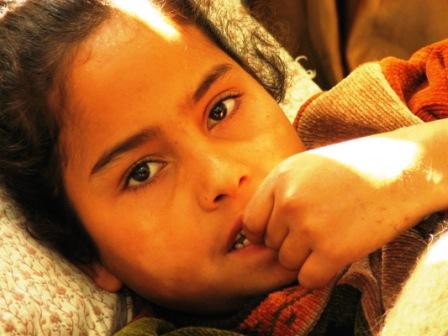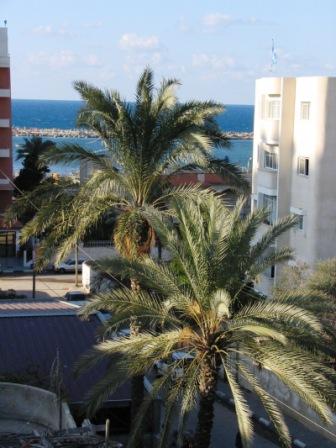|
 20:
"Gaza: worse than a prison, it is a graveyard" 20:
"Gaza: worse than a prison, it is a graveyard"

By Skip Schiel
Photos: injured girl in
Khan Yunis hospital, the Mediterranean Sea thru the window of the
American Friends Service Committee, Gaza City, January 2005
(Note: this is probably my
last Paired Photos while I’m in Palestine and Israel. Maybe one
more, from Cairo. And maybe this or that will be the end of this
series. Please watch for further developments.)
Seventy six years ago: A
Statement to the 1919 Peace Conference by prominent U.S. Jews
(including one Congressman):
We raise our voices in
warning and protest against the demand of the Zionists for the
reorganization of the Jews as a national unit, to whom, now or in
the future, territorial sovereignty in Palestine shall be committed.
This demand not only misrepresents the trend of the history of the
Jews, who ceased to be a nation 2000 years ago, but involves the
limitation and possible annulment of the larger claims of Jews for
full citizenship and human rights in all lands in which those rights
are not yet secure. For the very reason that the new era upon which
the world is entering aims to establish government everywhere on
principles of true democracy, we reject the Zionistic project of a
‘national home for the Jewish people in Palestine.’
...As to the future of
Palestine, it is our fervent hope that what was once a "promised
land" for the Jews may become a "land of promise" for all races and
creeds, safeguarded by the League of Nations which, it is expected,
will be one of the fruits of the Peace Conference to whose
deliberations the world now looks forward so anxiously and so full
of hope. We ask that Palestine be constituted as a free and
independent state, to be governed under a democratic form of
government recognizing no distinctions of creed or race or ethnic
descent, and with adequate power to protect the country against
oppression of any kind. We do not wish to see Palestine, either now
or at any time in the future, organized as a Jewish State.
-- Anti-Zionism:
Analytical Reflections, Roselle Tekiner, Samir Abed-Rabbo and
Norton Mezvinsky, eds., www.codoh.com/zionweb/ziondark/zionopp01.html
Like the Slaughter of the
Innocents, Herod driven merciless and brutal from fear, executing
all male children under the age of two because of the possibility
that new leadership might emerge, the children of Gaza suffer.
Mostly innocent, most no conceivable threat to any Israeli, they are
shot down.
Last week during my three day visit to the Gaza Strip, I met two, a
boy of 8 years, girl of 10. The boy was riding his bike, took a
bullet in his back shot from the Israeli army exhibiting "purity of
arms." Far from any possible military action, any Israeli
settlement, he was shot. He is in deep trauma. The girl was playing
with her friends on her roof. Again, no military activity, no
threats to settlers or the army, the Israelis hit her with a 50 mm
projectile, tearing thru her right arm. Doctors might save it. I had
the extreme privilege of meeting these two children in the Khan
Yunis hospital thru the good offices of the Gaza Community Mental
Health Program (GCMHP), invited to photograph the therapy--really an
initial interview to assess the children’s psychological needs.
Later in the taxi, thinking about what I’d just witnessed, I wanted
to scream and weep. Until now I’ve held those tears back, felt in
the taxi only a slight tearing, the water pulsing behind my eyes,
ready to stream out. Eventually, eventually.
The context is strangulation, Israel strangling Palestinians thru
the Occupation generally but most harshly in the Gaza Strip.
Currently [January 19, 2005], due to a Palestinian attack on a
commercial entry point, Karni, the Strip is totally sealed. In
addition, Israel’s Prime Minister Ariel Sharon has declared a
blanket halt to all contact with the Palestinian leadership,
including the newly elected president, Mahmoud Abbas. Even in the
best of times, Gaza is dangerous. While I was there—aside from the
problems of entrance and exit—in the southern section of Gaza City,
the Israeli army attacked alleged militants, shelling, bombing, and
firing missiles. Friends in that section of the city were terrified;
I slept blissfully thru it all.
Another aspect of the effect
of strangulation is the purported increase in the crime rate.
Although Palestine generally has a low rate (living in Ramallah and
traveling fairly widely in the West Bank, I can attest to at least
the perception of safety from crime), a Gazan told me Gaza City has
had 50 murders (Palestinian against Palestinian) in the past two
months.
I asked, why is Gaza
targeted for such severe pain? Various answers, among them: the
strength of the armed resistance (which is related to the
oppression, which preceded the other? if that is a valid question);
the geographical separation from most of the rest of the world and
the consequent absence of the media; the nearness to Egypt, factions
of which provide support including arms; and one not so widely held
view that the Strip has resources such as water desired by Israel.
Puzzling to me is the presence of Israeli Jewish settlers. There is
little historic Jewish activity in this area, so what is the
justification?
How is this oppression
resisted?
Public Achievement is a
program sponsored but the American Friends Service Committee which
hopes to teach youth leadership and survival skills. Those
completing the program are the coaches. Their imperative is to then
train more (and slightly younger) youth. This second high school age
group chooses a community service project that implicitly enlists
the support of national and local administrations and other
organizations.
In Gaza City there are two
projects. One group of girls chose to construct a library in a local
community organization (the Palestinian Committee for Inter
Communication). They then practiced their newly learned skills. They
solicited book donations, found space for the library, established a
way to supervise lending, and when I met them were finishing the
installation and rehearsing a program to formally open the library
the following day.
The second group of boys and
girls (two separate mixed gender groups joining for the final phase)
were landscaping a barren traffic circle near the sea. They had
planted trees and shrubs and were about to maintain them when I met
them. But first, a group session consisting of discussion about
democracy, games that built community (like having one leave the
room, the others choosing a leader, the absent one returning and
guessing who was leading the group in gestures), and a game that
might be titled, “Bang, bang, boom,” very close to the violence of
their culture, but turning it to play.
The first group was
exuberant, hard working, seemingly committed, and had prepared talks
and skits for the opening celebration. The second group was moving
against a strong cultural wind of separating the genders, but
despite that seemed to work together well.
I don’t know the outcome of
these two projects, nor of the Public Achievement projects in other
parts of Palestine such as Ramallah. I don’t know how effective the
GCMHP is in relieving trauma and anxiety. Nor do I fully understand
how any of these programs bring about the end of Occupation, if
indeed that is a cardinal principle. I do know that many of the
youth I observed were surviving, aiyish, and more than
surviving, thriving, happily, mubsut.
Trying to leave Gaza thru
the Arez checkpoint into Israel, a long labyrinthine gated funnel
system, with soldiers barely visible, shouting orders thru
loudspeakers-- remove your coat, lift your sweater, turn
around--standing to be x-rayed by some hi tech distant camera, after
driving to near the checkpoint, stopping, another loudpseakered
voice shouting, stop or I shoot, go back, you are forbidden to drive
thru (we walked), rifles pointed at us, striding past an armored
personnel carrier (just like the ones in Iraq), one hour later, we
emerged and drove off.
One final impression: Gaza
Strip is on the Mediterranean Sea. So Gazans looking west see an
expanse, a vista, limitless vision, freedom, but looking in any
other direction (except up, and then there are the tethered balloons
carrying remotely controlled cameras), they are imprisoned. Worse:
consigned to a graveyard, as one Gazan put it.
I’ve expanded this photo
selection on my website,
here
and here
Karni
Prime
Minister halts all ties with Abbas over terror, by
Amos Harel
and
Nir Hasson,
Haaretz, January 16, 2005
Gaza generally, via the Central Intelligence Agency of the United
States
Crime in Gaza
Public Achievement
American
Friends Service Committee in Palestine (needs updating)
Historic Jewish communities in Gaza
Maps of gaza—One
and two
Text from former US President Jimmy Carter
during the Palestinian elections on January 9, 2005--
I’ve archived all previous Paired Photo sets-- |
|



